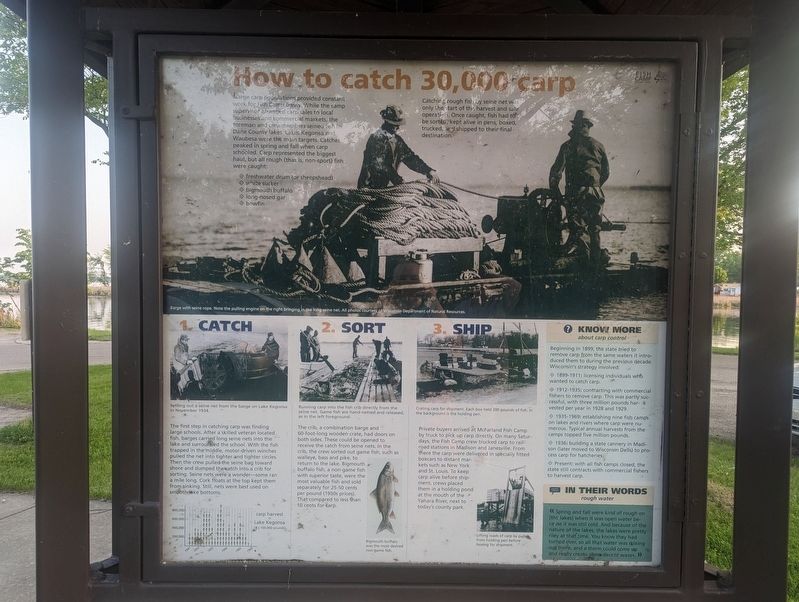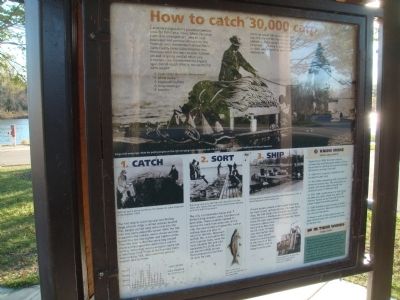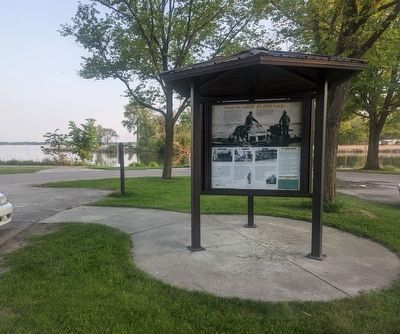Near McFarland in Dane County, Wisconsin — The American Midwest (Great Lakes)
How to catch 30,000 carp
° freshwater drum (or sheepshead)
° white sucker
° bigmouth buffalo
° long-nosed gar
° bowfin
Catching rough fish by seine net was only the start of the harvest and sale operation. Once caught, fish had to be sorted, kept alive in pens, boxed, trucked, and shipped to their final destination.
[Caption for main photo:] Barge with seine rope, Note the pulling engine on the right bringing in the long seine net. All photos courtesy of Wisconsin Department of Natural Resources.
1. Catch
[Caption for left photo in middle tier:] Setting out a seine net from the barge on Lake Kegonsa in November 1934.
The first step in catching carp was finding large schools. After a skilled veteran located fish, barges carried long seine nets into the lake and surrounded the school. With the fish trapped in the middle, motor-driven winches pulled the net into tighter and tighter circles. Then the crew pulled the seine bag toward shore and dumped the catch into a crib for sorting. Seine nets were a wonder--some ran for a mile long. Cork floats at the top kept them from sinking. Still, nets were best used on smooth lake bottoms.
[Graphic shows carp harvest in Lake Kegonsa in pounds from 1947 to 1969.]
2. Sort
[Caption on middle photo in middle tier:] Running carp into the fish crib directly from the seine net. Game fish are hand-netted and released, as in the left foreground.
The crib, a combination barge and 60-foot-long wooden crate, had doors on both sides. These could be opened to receive the catch from seine nets. In the crib, the crew sorted out game fish, such as walleye, bass and pike, to return to the lake. Bigmouth buffalo fish, a non-game fish with superior taste, were the most valuable fish and sold separately for 25-50 cents per pound (1950s prices). That compared to less than 10 cents for carp.
[Caption for left photo on bottom tier:] Bigmouth buffalo was the most desired non-game fish.
3. Ship
[Caption on right photo in middle tier:] Crating carp for shipment. Each box held 200 pounds of fish. In the background is truck to pick up carp directly. On many Saturdays, the Fish Camp crew trucked carp to railroad stations in Madison and Janesville. From there the carp were delivered in specially fitted boxcars to distant markets such as New York and St. Louis. To keep carp alive before shipment, crews placed them in a holding pond at the mouth of the Yahara River, next to today's county park.
[Caption for right photo on bottom tier:] Lifting loads of carp by pulley from holding pen before boxing for shipment.
Know More about carp control
Beginning in 1899, the state tried to remove carp from the same waters it introduced them into during the previous decade. Wisconsin's strategy involved:
° 1899-1911: licensing individuals who wanted to catch carp.
° 1912-1935: contracting with commercial fishers to remove carp. This was partly successful, with three million pounds harvested per year in 1928 and 1929.
° 1935-1969: establishing nine fish camps on lakes and rivers where carp were numerous. Typical annual harvests from the camps topped five million pounds.
° 1936: building a state cannery in Madison (later moved to Wisconsin Dells) to process carp for hatcheries.
° Present: with all fish camps closed, the state still contracts with commercial fishers to harvest carp.
In Their Words rough water
"Spring and fall were kind of rough on [the lakes] when it was open water because it was still cold. And because of the nature of the lakes, the lakes were pretty riley at that time.
You know they had turned over, so all that water was mixing out there, and a storm could come up and really create some decent waves."
Erected by Dane County Parks.
Topics. This historical marker is listed in these topic lists: Environment • Industry & Commerce. A significant historical month for this entry is November 1934.
Location. 42° 58.971′ N, 89° 15.899′ W. Marker is near McFarland, Wisconsin, in Dane County. Marker can be reached from Fish Camp Road, 0.3 miles east of County Highway AB, on the right when traveling east. The marker is in the parking lot at Fish Camp Park. Touch for map. Marker is at or near this postal address: 3383 Fish Camp Road, Mc Farland WI 53558, United States of America. Touch for directions.
Other nearby markers. At least 8 other markers are within 3 miles of this marker, measured as the crow flies. Working at Fish Camp (a few steps from this marker); All about nets (within shouting distance of this marker); Too many carp (within shouting distance of this marker); Fish Camp Launch (within shouting distance of this marker); Carp for sale (within shouting distance of this marker); Seasons of Fish Camp (about 300 feet away, measured in a direct line); Village of McFarland (approx. 2.4 miles away); Robert Marion La Follette, Sr. (approx. 2˝ miles away). Touch for a list and map of all markers in McFarland.
Credits. This page was last revised on May 24, 2023. It was originally submitted on October 16, 2011, by William J. Toman of Green Lake, Wisconsin. This page has been viewed 697 times since then and 44 times this year. Photos: 1. submitted on May 23, 2023, by Jess Draws of Madison, Wisconsin. 2. submitted on October 16, 2011, by William J. Toman of Green Lake, Wisconsin. 3. submitted on May 23, 2023, by Jess Draws of Madison, Wisconsin.


